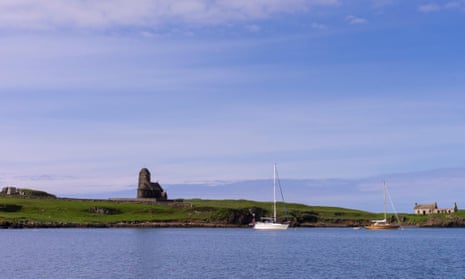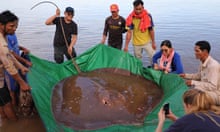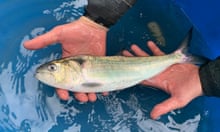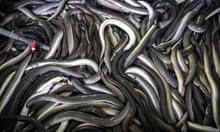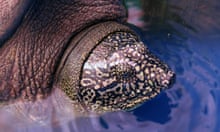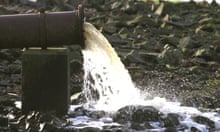The National Trust for Scotland has warned that a large salmon farm beside the Hebridean island of Canna could destroy the island’s culture and wildlife.
The trust, Scotland’s largest heritage charity, said the proposed fish farm posed unacceptable risks to the sea and the birdlife around the tiny island, and would put its booming tourism economy under great strain.
Mowi, the world’s largest aquaculture company, has tabled outline plans with Highland council to install eight super-sized fish pens close to Canna’s shoreline, to be stocked with 2,500 tonnes of organic salmon.
The NTS, which was given the island by the Gaelic folklorist John Lorne Campbell in 1981, has tabled a formal objection to Mowi’s proposals, accusing it of submitting flawed, incomplete evidence about the site’s environmental and economic impact.
It said the farm will sit in one of the UK’s most heavily protected marine areas, home to fragile sea life including the rare fan mussel and very close to seal “haul-outs”, where they haul themselves on to land, and vulnerable seabird populations. The farm could also affect wild salmon and trout migrating to and from Skye, less than 10 miles away, the NTS said.
Mowi argues that an organic farm is more sustainable than a conventional salmon farm as it holds a third less fish. The NTS estimates it would still discharge as much organic waste each year – faeces, uneaten fishmeal and dead fish – as a town the size of Dumfries or Lichfield (population about 35,000).
Stuart Brooks, the trust’s head of conservation and policy, said it had a duty to protect Canna’s cultural and natural heritage. The island and its surrounding seas are protected by six wildlife and geological designations, including a marine protected area, with six other protected areas nearby.
“Based on the information provided by Mowi so far about their fish farm proposals, we have no confidence that their plans would not undermine, if not destroy, the very things that make Canna so important,” he said. “In all conscience, we cannot support Mowi’s proposals.”
An island with a population of 18, Canna is famed for Lorne Campbell’s large Gaelic archive and for its archaeology and wildlife, which includes the rare Canna mouse, a subspecies of fieldmouse.
The NTS and the Royal Zoological Society of Scotland spent £600,000 eradicating brown rats from the island 10 years ago, in part to protect the Canna mouse but also to bring the island’s Manx shearwater population back from the brink of extinction.
The trust warns there is a “serious risk” that rats will be brought back by Mowi’s service vessels. Mowi said it would strive to stop that happening and would pay for an eradication programme if its vessels were to blame.
One of four inhabited islands known as the Small Isles, along with Eigg, Rum and Muck, Canna has suffered a long-term population decline and several failed attempts by the NTS to attract new residents. The trust handed control of its regeneration strategy to the islanders in 2017.
Its economy is heavily dependent on summer tourism, subsistence farming and the NTS warden and archivists working at Canna House, the home shared by Lorne Campbell and his wife Margaret Fay Shaw, a musician and photographer.
Mowi, a Norwegian-owned multinational, said the farm would need 10 staff and would boost Canna’s economy. Some will be based there part-time, but Mowi has offered some jobs to islanders, who are still mulling over the proposal.
It already has two salmon farms off Rum and Muck that employ local people, but the NTS said the Canna site, which will cover 16,000 sq metres and sit close to the picturesque harbour, will deter tourists, cruise ships and yachts, reducing the island’s main source of income.
Mowi said the Canna scheme would allow it to close down two sites on the Scottish mainland close to sensitive wild salmon habitats, including one at Loch Ewe blamed for devastating wild trout stocks at Loch Maree nearby.
The company has promised all its Scottish sites will be accredited by the Aquaculture Stewardship Council, which has tighter rules on chemical use and marine pollution, by 2020, in response to attacks from MSPs and environmentalists on the industry’s environmental record.
Mowi argues an organic farm would have a lower impact, partly because the Canna site will be exposed to strong tides and open sea. NTS challenged that assertion, since the Soil Association, the organic accreditation and rule-making body, still allowed toxic chemicals to be used twice a year.
Mowi said it was disappointed NTS had publicised its objections, adding: “Our science experts will continue to work with the Canna Development Trust to explore the potential for a sustainable aquaculture development, and look forward to discussing scientific evidence that is the basis for Canna’s decision whether to proceed.”
